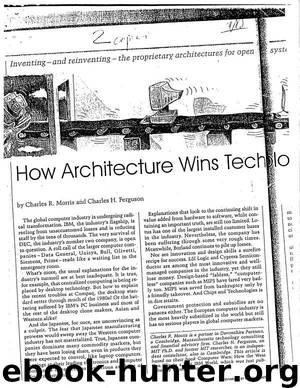How Architecture Wins Technology - HARVARD BUSINESS REVIEW by Charles R. Morris & Charles H. Ferguson

Author:Charles R. Morris & Charles H. Ferguson
Language: eng
Format: epub
Tags: WAIS, Internet History
Published: 1993-03-25T16:00:00+00:00
I
yS-
crease market penetration. But Sony outperformed Philips and took half the market. Philips^s standar.d was a static one that it never developed further.
Lock-in. A company has a "lock" on an architecture when competitors are trained to wait until the architectural leader introduces each new product generation. Intel and Microsoft; at least temporarily, seem to have achieved this position in PC markets. Sun was on the verge of a locked in franchise in workstations but may have fallen short, the performance of its SPARC RISC processor design has been lagging behind the competition, and the company neglected to solidify its franchise by moving rapidly down to lower end platforms.
But lock-in is sustainable only when a company aggressively and^coiitmiioUsly cannibalizes its own product liiie and continually and compatibly extends the arcKitecture itself; this is a strategic choice"thaFmany companies find difficult to make. Often, managers become overprotective of the products that brought them their original success. IBM, for example, has frittered away a powerful lock on back-office transaction processing and operating systems. In a misguided effort to protect hardware sales, it has refused to release products, long since developed internally, that would adapt its best-selling AS400 minicomputer software to the RS6000 workstation. Such reflexive self-protection sirtlply hands over a valuable franchise to the Microsafts and other vendors storming up from the
low end.
HaTvest. Of course, the ultimate objective of architectural competition is to win a market leader's share of the profits. Just to give one dramatic exarn-pie, profit margins on Intel's xx86 family of chips are in the 40% to 50% range and account for well
Though painful, It is absolutely necessary to cannibalize old architectures. __
over 100% of the company's earnings. But no locked-in position is ever completely,safe, and companies must be careful when they harvest not to rest on their previous successes. Indeed, Intel may have harvested too aggressively, drawing out spirited recent attacks by clone maker's such as AMD arid Cyrix.
Just as products must be cannibalized, so must architectures themselves. The better the architecture, the longer its lifespan; but sooner or later every architecture, no mat-■"T ter how well designed, becomes ob-
■Ov solete. And before it does, the mar-
jT^^ ket leader must be prepared to
move ahead, to do away with the old and introduce the new. Industry leaders often fail to cannibalize their old architectures, but although nothing is more painful, to do so is absolutely necessary. Otherwise, competitors quickly move to create and introduce rival franchises, and these eventually dominate the industry. IBM's failure to cannibalize its mainframe and minicomputer franchises provides a stark example of the catastrophic effects of waiting too long.
DEC provides another example. The company developed outstanding RISC products very early. But DEC declined to cannibalize its profitable VAX-VMS architecture because its VMS operating system, the source of its franchise, was tightly integrated with its aging VAX hardware. Predictably, DEC was beaten out by vendors such as Sun Microsystems and Microsoft, which didn't hesitate to move in with their newer, more powerful alternatives. (The main developer of DEC's advanced systems, Dave Cutler, is now in charge of developing NT for Microsoft.
Download
This site does not store any files on its server. We only index and link to content provided by other sites. Please contact the content providers to delete copyright contents if any and email us, we'll remove relevant links or contents immediately.
The Brazilian Economy since the Great Financial Crisis of 20072008 by Philip Arestis Carolina Troncoso Baltar & Daniela Magalhães Prates(117003)
International Integration of the Brazilian Economy by Elias C. Grivoyannis(86824)
The Art of Coaching by Elena Aguilar(52845)
Flexible Working by Dale Gemma;(23232)
How to Stop Living Paycheck to Paycheck by Avery Breyer(19604)
The Acquirer's Multiple: How the Billionaire Contrarians of Deep Value Beat the Market by Tobias Carlisle(12190)
Thinking, Fast and Slow by Kahneman Daniel(11988)
The Radium Girls by Kate Moore(11877)
The Art of Thinking Clearly by Rolf Dobelli(10150)
Hit Refresh by Satya Nadella(9001)
The Compound Effect by Darren Hardy(8742)
Tools of Titans by Timothy Ferriss(8163)
Atomic Habits: Tiny Changes, Remarkable Results by James Clear(8130)
Turbulence by E. J. Noyes(7903)
Change Your Questions, Change Your Life by Marilee Adams(7575)
A Court of Wings and Ruin by Sarah J. Maas(7569)
Nudge - Improving Decisions about Health, Wealth, and Happiness by Thaler Sunstein(7473)
How to Be a Bawse: A Guide to Conquering Life by Lilly Singh(7349)
Win Bigly by Scott Adams(7041)
